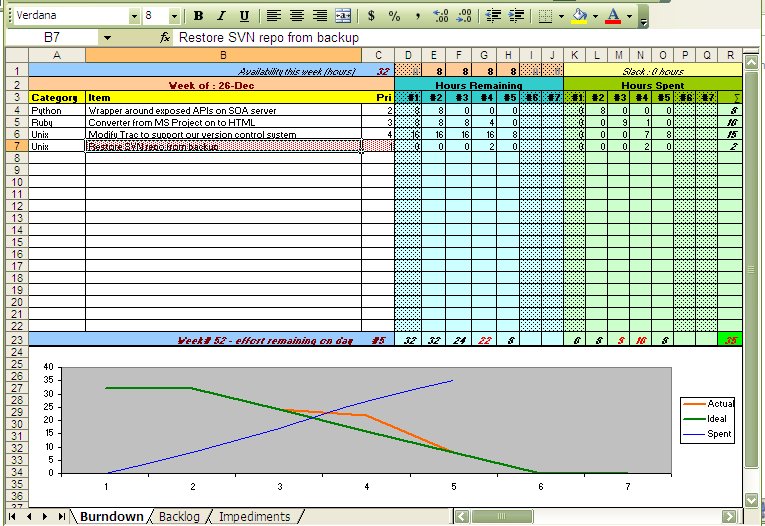Related Entries
Labelling in Outlook 2003 ala Gmail
Time tracking tools
Outlook 2003 + Flags = todo list
Scrum for Self : V2
ADD and antipatterns
« Dino eats frog
» RLT: Palakkad to Bangalore
Scrum for self
I’ve been managing software development for products since March 2004. I also play the role of a software architect and configuration manager, so I have my own tasks as well. So, as an individual contributor, I wanted some way to plan my work without having to fiddle with MS Project. For my team, I used principles of Scrum in the form of simple burndown charts and backlog lists - it worked very well. Here is my adaptation for using it as a tool for Scrum for one person, for weekly sprints.

- Download the MS Excel 2003 version of the template.
- In the Burndown sheet, specify the date for beginning of the week and the hours you’ve available each day.
- Now, go to the Backlog sheet and pick up stuff you want to do this week. Move this over to the Burndown sheet.
- As a rule, all the cells in italics are calculated - you needn’t update these.
- Every day of the week, in the morning, update your estimate of how many hours are remaining for each task. Also update how many hours you spent the previous day.
- You can see whether you’ve slipped or gained by looking at the chart and at the top-right cell.
- If you get an unplanned task during the week, and if you must do it, add it to the Burndown sheet. If you put zero as the hours in effort remaining section for the previous days, the sheet will automatically highlight this as an unplanned task.
- End of the week, create a new Excel file for the next week. Copy existing backlog entries and any new ones to the backlog. Repeat the process as above.
Here is a movie that helps you visualize this.
If you are interested, here is how I am managing the team these days. Tools of trade to plan, track and escalate are simple.
- I use MS Project to plan the project.
- Export this into HTML (using mpp2html) and publish the HTML to a Wiki page.
- Break down the plan into small sprints or timeboxes, usually of 2 weeks each.
- Every morning, have a standup meeting where I track the progress.
- This is tracked using one Excel I found over the web, that I customized for my needs. Essentially, I mix data from MS Project and Excel so that I know how we are slipping or gaining.
- I track impediments as a tool for escalation (if need be).
project_management